Previously in Comics 101: As our mammoth coverage of James Robinson’s STARMAN series winds down, we find Jack Knight in an unexpected place: with the help of his friends, he’s saved Opal City, and even found the son he’d thought lost forever, but at a heavy price: the death of his father, Ted Knight, the original Starman. The final chapter in the STARMAN saga begins with a city, and a son, saying goodbye…
Jack, and the rest of Opal City, said goodbye to Ted Knight at Opal’s Starman Museum, built on the site of Ted’s old observatory, which had been blown up by the Mist back in the very first story arc.

Ted wasn’t the only loss to suffer, as Matt O’Dare had been mortally wounded saving his family from their traitorous brother, and his family and friends gathered around as he lay dying in the hospital, where, just before the end, he had a sudden revelation:

The good news was that Jack wouldn’t be protecting the Opal by himself any more, as Black Condor and the Dibnys had elected to stay.
However, Jack’s sorrows weren’t done yet, as he’s rocked by yet another blow: Sadie had left him, without saying a word, skipping town and leaving only a letter to explain her departure. However, we know what Jack doesn’t: that Sadie is pregnant with Jack’s child, and she’s afraid to bring a baby into Jack’s dangerous superhero world. It’s a moment Jack’s not ready for:

Duty calls, and Jack must attend his father’s memorial service, officiated by Opal’s new acting police commissioner, Clarence O’Dare.
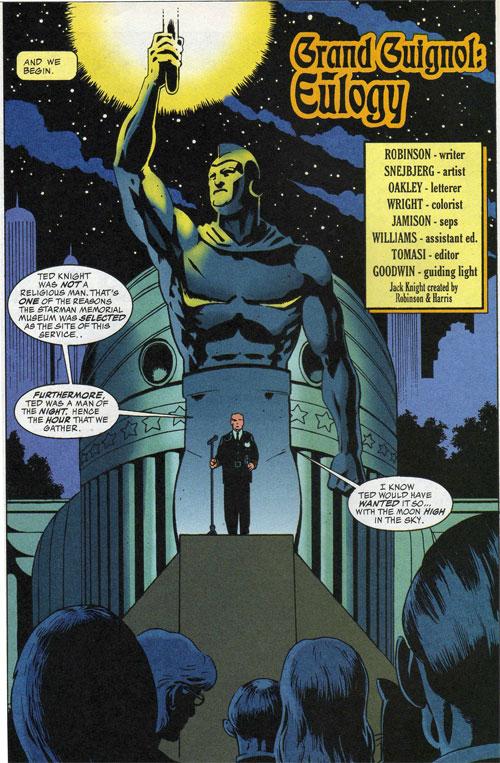
Many of Ted’s friends and teammates speak, including Jay Garrick, Ted Grant and Alan Scott. Note the tiny touch from Snejbjerg in the final panels, as the tears begin to run down Green Lantern’s face:

Maybe the most eloquent tribute is paid by the Shade, a man who had almost fancied himself removed from humanity until the days of late:

The final words are left to a grieving Jack Knight, stressing more of the humanity in Ted’s life than the superman:
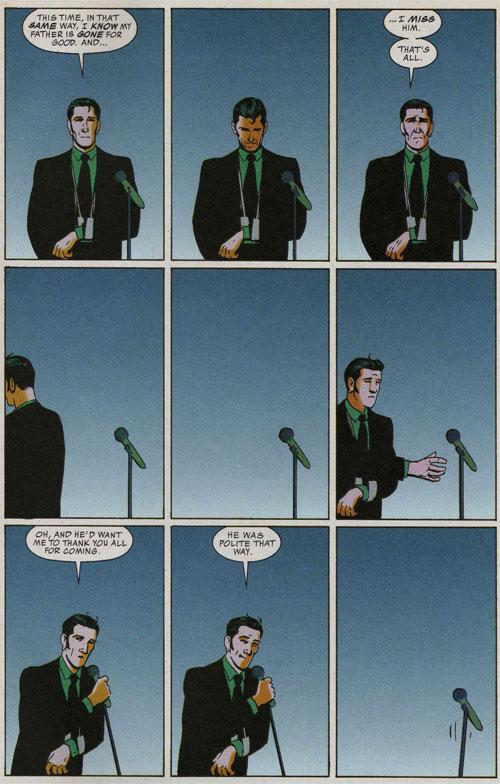
Next up was STARMAN #74, the last of the series’ “Times Past” flashback issues, which told the story of Brian Savage’s final days as Sheriff of Opal City in the year 1899.

Handling the art here was comics legend Russ Heath, who brought a gritty reality to the grim tale, in which Savage goes on a vengeful rampage after most of his deputies are murdered by a secret elite society within the Opal. All bets are off after that, as Savage reverts to the old ways to get some answers:

Unfortunately, this is one of the issues not collected in any of the trades, but as it serves as the capstone to the long-running tale of Brian Savage and the early days of Opal City, it’s quite necessary, so track it down if you can.
Getting back to the present, Jack had a few last DC Universe appearances before he made his swan song in his own series, first in the YOUNG JUSTICE crossover event SINS OF YOUTH, which saw he and the rest of the JSA magically transformed to little kids while their teenaged counterparts find themselves suddenly adults, including Courtney Whitmore, the Star-Spangled Kid, who suddenly finds herself pressed into the role of Starwoman and riding herd of over a mob of JSA kiddies, including a rambunctious li’l Jack.
Jack also returned to the pages of JSA for issues 11 through 15, the team’s battles with Kobra and Extant. Unlike the first JSA story arc, which definitely featured Jack in a prominent role, here Jack was mostly a background player in the by-this-time overcrowded Justice Society. Jack’s spotlight moment comes in issue #12, where Jack talks Atom-Smasher out of cold-bloodedly killing the murderer of his mother:
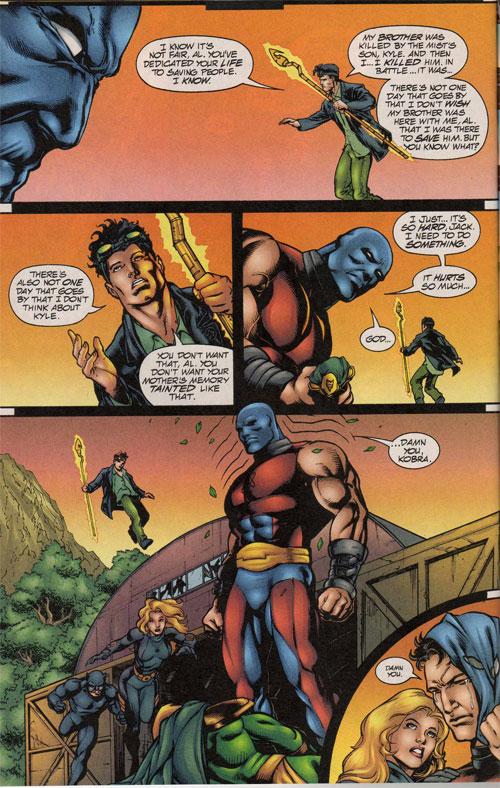
Jack fights bravely alongside the team as they take down Extant, the time-travelling villain responsible for the deaths of several JSAers back during ZERO HOUR, but at mission’s end elects to leave the team:
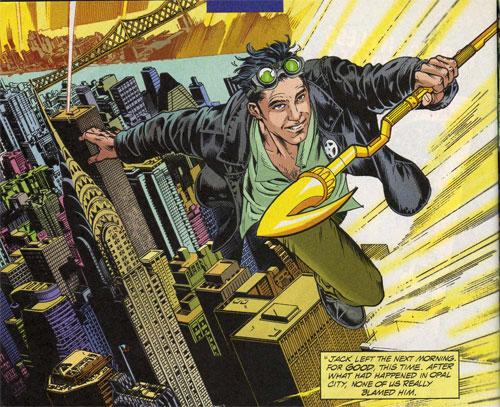
Getting back to the Opal, STARMAN #75 finds Jack adjusting to life in an Opal on the mend splitting his time between patrolling the skies and caring for his little one. Still, Jack feels lost somehow, and goes to his father’s museum, in the hopes of finding a little clarity. Once there, he’s met by a surprise:

Yes, Superman had come calling, and surprisingly, it was a personal matter. Superman had heard through the grapevine that Jack had traveled through time during his space adventure, and had met Superman’s father on Krypton. The two talk about their fathers (with a brief interruption to handle some rather goofy-looking armored bank robbers) and Jack asks Superman for some advice: he’s thinking of hanging it up:
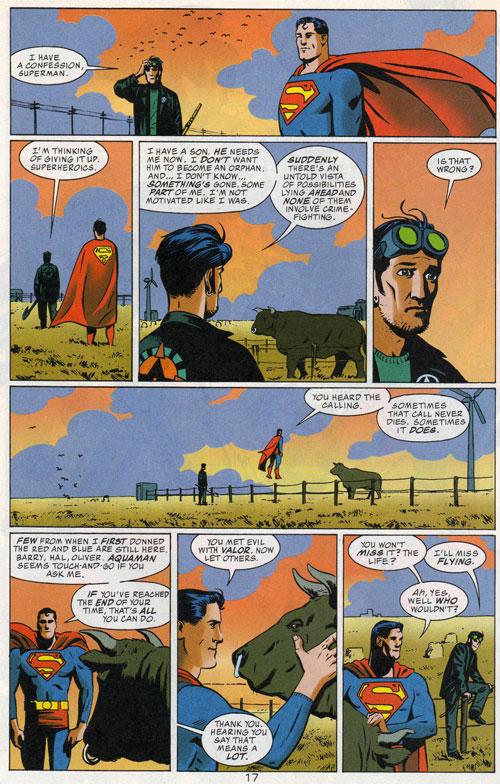
Superman takes his leave, but not before asking Jack why he didn’t warn Jor-El of Krypton’s fate. Jack’s answer is meandering but fair:

Jack is left alone at the Starman Museum, wishing he’d had that last conversation with his father, the one that we all wish for after losing a loved one. The difference for Jack, as his world turns a familiar black and white, is that he’ll get his chance.
STARMAN #76 brings us the final “Talking With David” issue, and after two installments of David talking to Mikaal instead of Jack, it’s a welcome return. And even better, David doesn’t come alone, bringing along Ted as well, so Jack gets his opportunity he thought was lost forever:

It’s also finally explained just how David was able to cross over to meet with Jack, a combination of Jon Valor’s curse on Opal (that the dead should never rest, remember?) and a little mystical assistance from another of Ted Knight’s old and departed teammates, Kent Nelson, the former Dr. Fate. However, with Valor’s curse broken in “Grand Guignol,” this would be their final visit. Together, Jack, David and Ted look through the history of the Starman lineage, at all the men who’d worn the star, the high points and the low.

In a surprising and oddly touching moment, Jack has another visitor: Kyle, the Mist’s son, whom he’d killed in his first adventure, who has a message for Jack:

Their time up, Jack says goodbye to his father and brother, but then realizes at the last second that there was one Starman they neglected to mention: the mostly forgotten, mysterious Starman of 1951, who operated in Opal for a year and a day while Ted Knight was in a sanitarium, suffering from guilt-induced psychosis over having been involved in the Manhattan Project. He’d been mentioned sporadically over the course of the series, but only in passing and without elaboration. Cryptically, Ted and David tell Jack they didn’t forget, and the black and white of the world around Jack fades back to color, as Jack finds himself face to face with the orange-and-red-garbed Starman, and realizes where he is: the year 1951.

After Jack and the mysterious Starman fend off a nattily dressed Mist and his goons, the two retreat to Starman’s hovering starcraft, where Starman reveals himself:
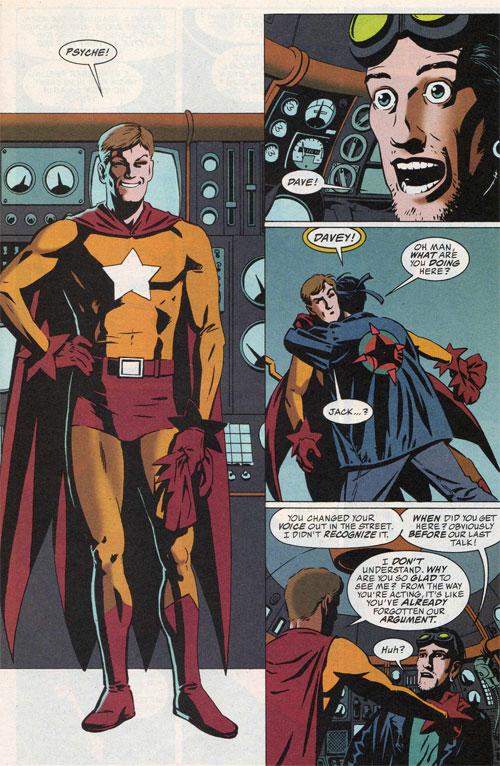
Yes, it’s David sent back to 1951 by Dr. Fate, just moments before his death, to live out his dream of being Starman, if only for a month (David takes over the role from Charles McNider, a.k.a. Doc Mid-Nite, who traveled to the Opal to take care of a crime wave in Ted Knight’s absence, and elected to do so in more native garb). Together, Jack and David have an adventure together as Starmen, alongside Hourman and eventually their father, who returns to the red and green to help take down the Mist’s traitorous scheme. Jack’s three-issue adventure in 1951 is a great little capstone for the series, allowing him to go off on one last adventure with his brother before he hangs up the goggles and staff to raise his child. It does end on a slightly creepy note, as David is pulled away from 1951 to his fated death right before Jack’s eyes.
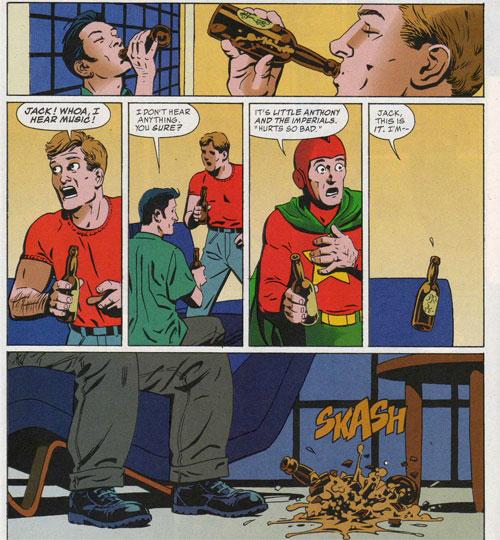
This is another example of the unique artistic quality Peter Snejbjerg brought to the book; the two shots of David here still put a little chill down my spine.
Thanks to a ride back to the present from future Starman Thom Kallor (the Legionnaire Jack had met on his space adventure), Jack was returned to the Opal in STARMAN #80, and set about preparing to give up his role as Opal’s protector. Making his decision a little easier was a letter from Sadie, which finally revealed to Jack the reason she’d left, and begged him to move to San Francisco to be with her and their soon-to-be born child. Jack’s decision?
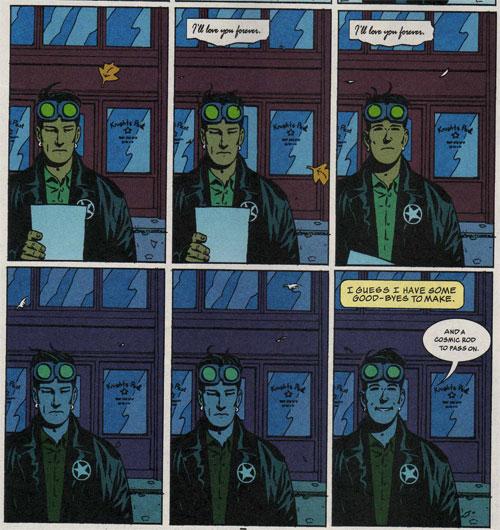
Jack goes and sees all of Opal’s protectors new and old, the O’Dares, the Dibnys, Black Condor, Bobo Bennetti, to insure his town will stay in good hands. Jack pays his respects to the Shade as well, who gives him a piece of the Opal to take with him:

Finally, Jack meets with the person he’s chosen as his successor: Courtney Whitmore, the Star-Spangled Kid. Jack gives her his cosmic rod, his goggles and his jacket, and in return she gives him a promise:
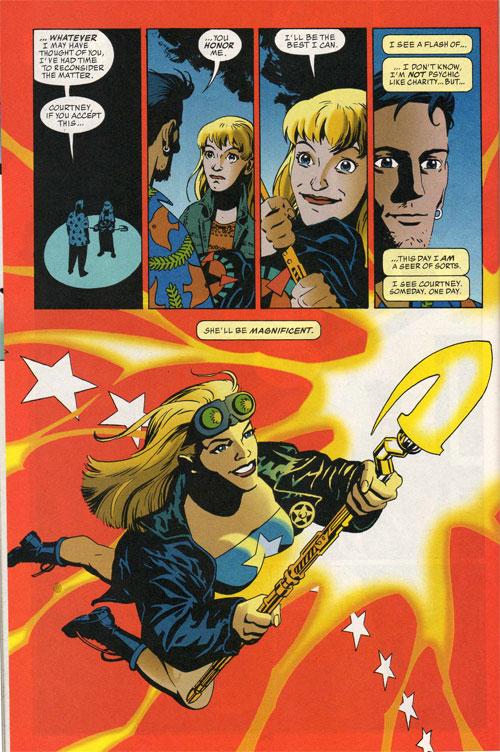
And with that, Jack Knight packs up his car and his baby son, and drives out of Opal City, and the DC Universe, presumably forever.
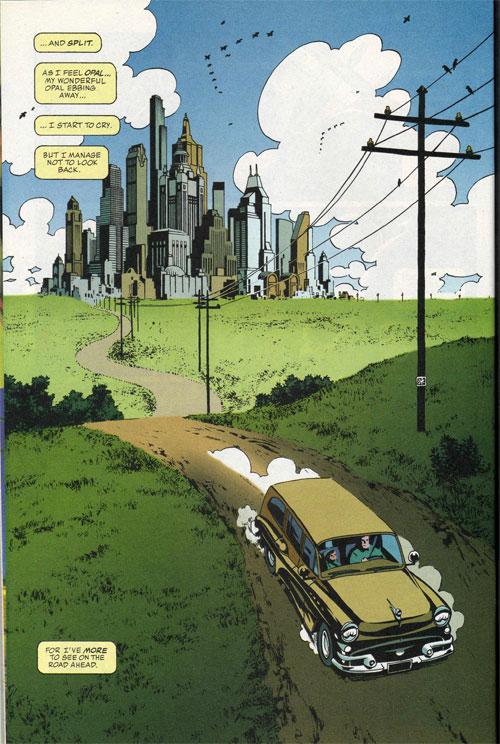
Very few great characters in comics ever really get the privilege of an ending. The very nature of the American comics publishing system has been that popular characters run on and on for years and decades, as long as they continue to earn money for their publishers. Even fewer are given the chance to be ended by their creators, and done so in the manner they’d always intended. As much as I miss having new Jack Knight stories to read, I’d much rather see it ended properly by James Robinson than see Jack fade into the background of the DC Universe until somebody decides they want some cheap shock value and decide to kill him and his family off. DC has been as good as their word to Robinson as well: no one has messed with Jack since the series ended, and Opal, while not featured prominently, remains still standing as well. (Of course, the same can’t be said for so many of Jack’s “Grand Guignol” co-stars, like Ralph and Sue Dibny, Phantom Lady and Black Condor. And people thought being in the JLI was a death sentence…)
One of the toughest tricks to pull off in superhero comics is real growth of character, and that more than anything else is what makes STARMAN stand out from the rest. Jack Knight was a unique character when we met him, and over the course of the next seven years, we saw him change and mature, from callow irresponsible hipster to mature, responsible family man and hero. Jack’s not the same man he was at journey’s end, but he’s still Jack. At the same time, a greater world was created around Jack, one that took elements and ideas and characters from the larger DC universe and history, but reconceived them into something entirely new; not just Opal City but, the very feel and tone of Jack Knight’s world, one part Golden-Age nostalgia, one part moody noir, one part poetic elegance. James Robinson, Tony Harris and Peter Snejberg accomplished that, through their words and drawings, and I’m hard-pressed to think of many other accomplishments in comics that can say the same.

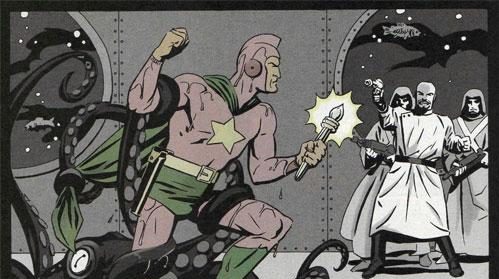
Comments are closed.